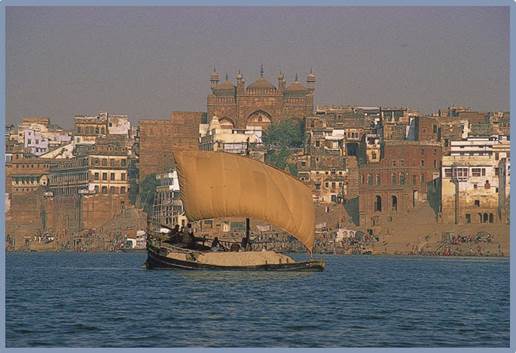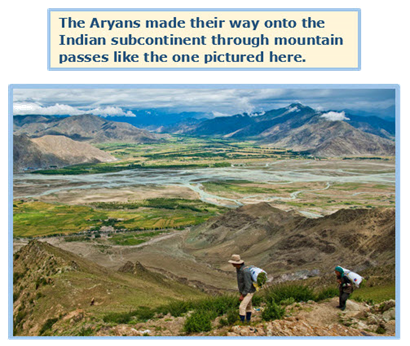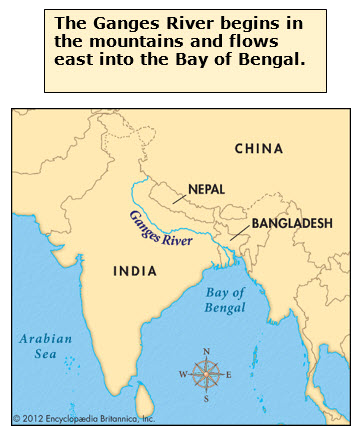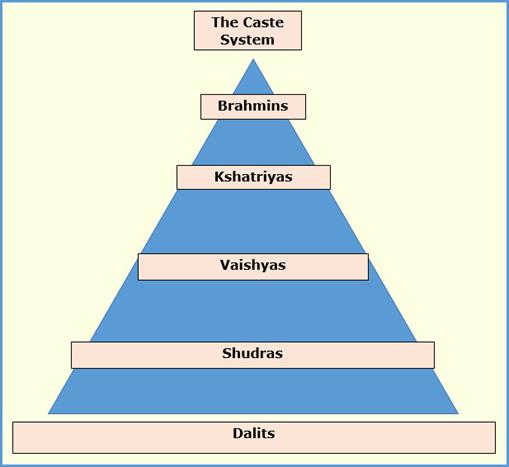ANCIENT INDIA—PART 2

Boat on the Ganges River
Unit
Overview
About
1500 BCE, groups of nomads from central Asia crossed the mountains and settled
on the Indian subcontinent. Some of
these people called themselves Aryans, which meant nobles in their language.
They would build a new civilization along the Ganges River and establish
a culture that continues to impact life in the Eastern Hemisphere today. Let’s see how it all happened.
The
Arrival of the Aryans
In
the years following the collapse of the Harappan civilization, a group of
people called Aryans arrived on the
Indian subcontinent. Historians tell us
that they were not a separate race. The
Aryans were part of a larger group, known as Indo-Europeans, a people who originated in central Asia. Beginning around 2000 BCE, some
Indo-Europeans migrated to Europe.
Others, such as the Aryans, moved south through mountain passes in the
Hindu Kush and Himalayan Mountains. They
arrived in the Indus Valley about
1500 BCE. During the next five hundred
years, they built a civilization that, with the exception of the southern tip
of India, extended over all of the subcontinent.

In
many ways, the Aryans were very different from the people already living on the
Indian subcontinent. They were nomads without permanent homes and were
not farmers who remained in one place.
Although their herds constantly required land for grazing, they provided
meat, cheese, butter and milk. Families
measured their wealth by then number of cows that they owned. The Aryans also rode horses and drove wooden
chariots. They loved eating, drinking,
playing games with dice and racing horses.
From
Nomads to Farmers
Over
time, the Aryans mingled with the native people, who were called Dravidians. They stopped being nomads and became
farmers. The same technology that they
had used to make iron tips for arrows soon produced better tools. The invention of the iron plow and the
production of heavier, sharper iron axes enabled the Aryans to clear the dense
rainforests of the Ganges Valley. They
built canals for irrigation and pools for storing water. Nonetheless, transforming the jungle into
farmland was a dangerous project.
Workers battled tigers, lions, elephants and other animals whose
habitats were being destroyed. Poisonous
snakes were also a serious threat. In
spite of these problems, farms along the banks of the Ganges River were soon
yielding large harvests of wheat, barley and millet.

The
Aryans also brought their religious beliefs with them. Their polytheistic faith included a large
number of gods and goddesses, such Indra
(the god of war), Varuna (the god of
creation) and Agni (the god of
fire). Rituals, ceremonies and prayers
were very important. If they were
carried out properly, people believed that the gods were likely to grant
health, wealth and success in battle to their worshippers. Because the Aryans had no written language
when they first came to India, priests memorized long hymns and prayers. They recited them in an early form of Sanskrit, their spoken language.
By
500 BCE, the Indian people developed a written language. For the first time, priests wrote down the sacred
prayers and hymns. This collection of
religious writings and teachings is called the Vedas. The Vedas have provided us with valuable
information about life in ancient India. They also became the basis for the Hindu faith, which is the world’s third
largest religion today. The Vedas were so influential that
historians sometimes refer to this period of Indian history as the Vedic Age. Click
on the graphic below to learn more about the Vedic Age.
For
a long time, the Aryans and the Dravidians did not have a large kingdom with a
single ruler. Instead, tribes, whose
leaders were called rajahs, fought
to control trade and territory.
Eventually, some rajahs became powerful rulers and built walled cities
in the Ganges Valley. Around 300 BCE, Chandragupta put together a massive
army consisting of over 700,000 soldiers and 9,000 elephants. He conquered one group after another until he
formed an empire that included almost all of the subcontinent.
The
Caste System
The Vedas include a story that explains how
the gods created four distinct groups of people. This became the pattern for organizing Indian
society and led to the development of the caste system. A
caste is a social class whose members are identified by the work that they
do. A person belonged to a specific
caste from birth. This did not change
throughout his or her lifetime. Each
group had its own occupation that was passed down from parent to child. Their caste determined whom people married,
how they made their living and who their friends were. Why was this system created? No one knows for
sure, but here is one idea offered by historians. The native people of the subcontinent greatly
outnumbered the Aryans. It is possible
that the caste system was a way to establish rules for everyone’s behavior and
to maintain order.
Like
the societies of other ancient civilizations, Indian society can be pictured as
a pyramid. Although there were actually
hundreds of different castes, they were categorized into four main
divisions. Priests, or Brahmins, made up the small, elite
group at the top. Warriors and
government officials were considered Kshatriyas
and ranked just below the Brahmins. Landowners,
merchants and craftsmen were classified as Vaishya. Laborers and slaves were referred to as Shudras.

The
lowest group in Indian society remained outside the caste system. They were referred to as Dalits, or untouchables.
They did the work that no one else wanted to do. The untouchables, also referred to as
outcasts, were forced to live apart from everyone else. If they traveled, the carried two sticks
which they tapped together to warn others to stay away. Today, the nation of India has a democratic
government and a constitution that outlaws discrimination based on caste. However, laws cannot totally erase centuries
of tradition.
Along
with the caste system, life in ancient India centered on the family. The oldest man in the family was in charge
and made most of the decisions. For
example, parents arranged marriages for their children, but the head of the
family had the final say. Women had very
few rights in this society. Unlike
Egyptian women, they were forbidden to inherit property or to hold government
positions. Boys from noble families
attended schools, but girls were taught at home.
The
Legacy of Ancient India
Even
though they lived a long time ago, the ancient Indians continue to impact the
modern world. In fact, you rely on some
of their contributions every day. Can
you imagine life without the numbers one through nine or zero? These numerals originated in India thousands
of years ago. Arab traders found them
useful when they exchanged products with the people of the subcontinent. The Arabs also traded with Western
Europeans. They, too, began to use the
Hindu-Arabic numerals to conduct business.
The Indians developed a number system based on ten. We call this the decimal system today. In a number like 7,400, each numeral is worth
ten times as much as the numeral to its right.
Of course, none of this would work without a symbol for zero, which
originated in India. Learn more about
the development of the decimal by watching the video below.
Math
concepts are not the only ways that the ancient Indians continue to influence
our lives. Some of our current ideas
about good health and wellbeing come from them.
Yoga is a popular exercise
that relaxes the mind and body. It was
used for the same purpose on the Indian subcontinent centuries ago. Recently, scented oils have become
popular. They create a feeling of peace
and help to prevent the spread of some diseases. Using them for the same purposes was common
practice in the Indus and Ganges River Valley.
Through the work of archaeologists, we also know that the Indians were
the first to do a form of plastic surgery.
Through trade, they passed on new technology for the iron-making
process. The tools that they created made
farming more efficient and increased harvests.
The video listed below explains more about the Indian expertise in
iron. At the same time, two of the
world’s major religions, Hinduism and Buddhism, began here. Their influence is now felt across the globe.
Time
for a Quick Review
Before
moving on to Unit 16, review the names and terms found in Unit 15. Be sure you can answer the “Can I” questions
with a loud “yes”.


Additional Activities and Resources
Chandragupta Maurya (article courtesy of Thought Co.)